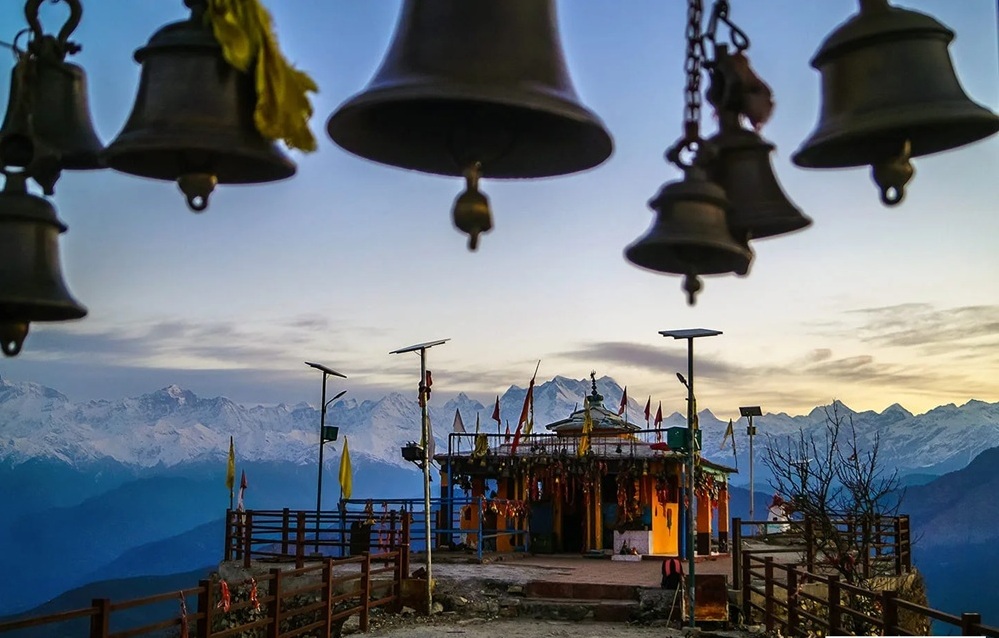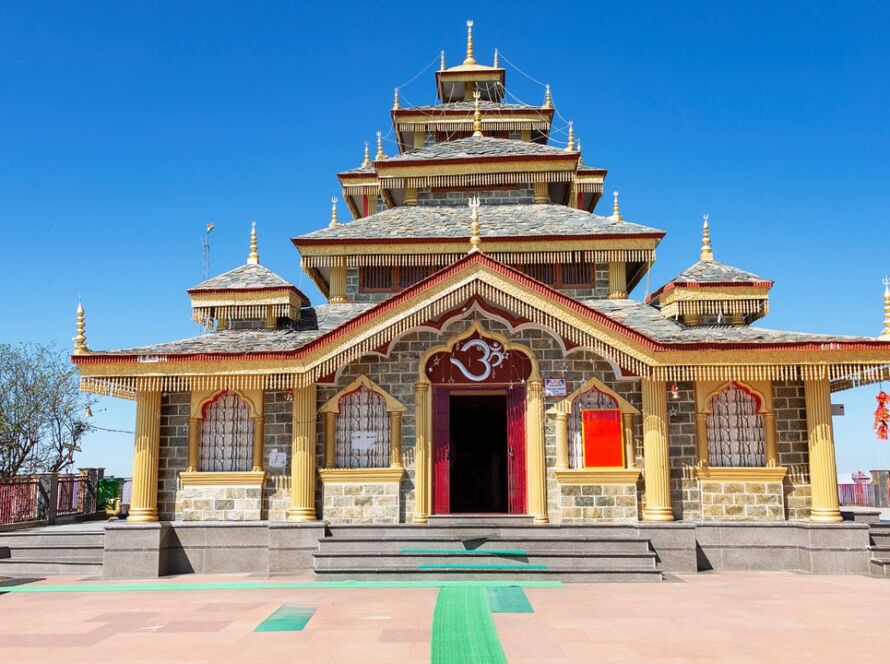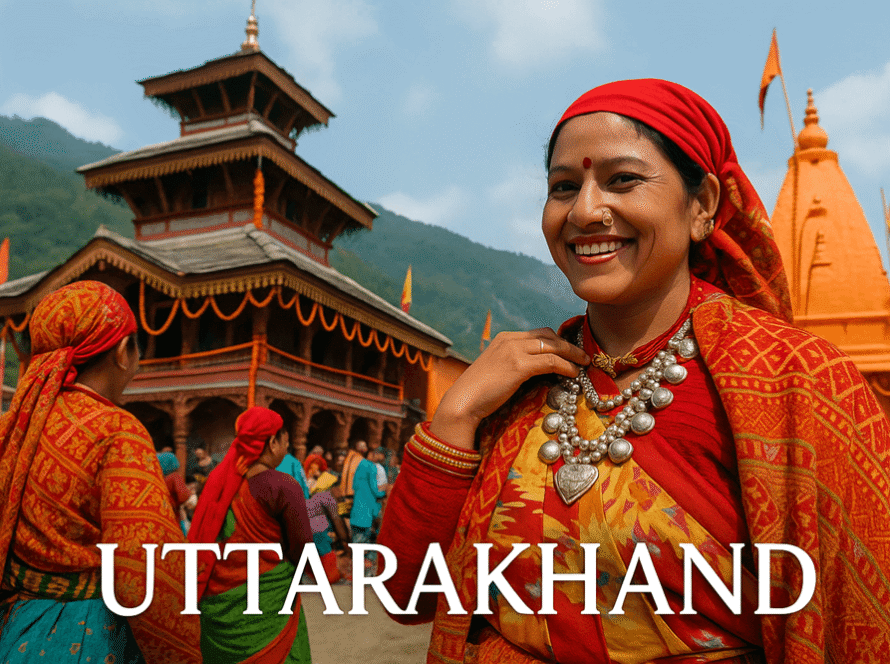Have you ever dreamed of standing on a cliff with 360-degree Himalayan views while listening to bells echoing through the valleys? The Kartik Swami Temple in Uttarakhand offers exactly that. Perched at 3,050 meters above sea level, this temple is dedicated to Lord Kartikeya, the son of Lord Shiva and Goddess Parvati. Beyond its spiritual significance, the journey to Kartik Swami Temple is a soul-refreshing trek filled with panoramic mountain ranges, pine forests, and serene landscapes.
In this guide, we’ll uncover the history, cultural legends, trekking details, highlights, fascinating facts, and practical travel tips for visiting Kartik Swami Temple. Whether you’re a spiritual seeker, a trekking enthusiast, or simply someone longing for untouched Himalayan beauty, this temple has something to offer.
HISTORICAL AND CULTURAL CONTEXT
The Kartik Swami Temple holds deep mythological significance in Hinduism. According to legend, Lord Shiva once declared that whoever circled the universe first—between his two sons Kartikeya and Ganesha—would be worshipped first. While Kartikeya set off on his peacock to travel the universe, Ganesha circled his parents, symbolizing that they represent the universe itself. Lord Shiva was pleased and declared Ganesha as the first deity to be worshipped. In disappointment, Kartikeya left Mount Kailash and came to the Himalayas. It is believed that he resided here, and hence this temple was built in his honor.
The temple is not only a place of worship but also a cultural symbol of devotion and sacrifice. Local folklore says that Kartikeya offered his bones to his father, and hence the temple houses a stone idol representing his skeletal frame. The annual Kartik Purnima festival sees hundreds of devotees gather here, celebrating with prayers, hymns, and rituals.
For the people of Garhwal, Kartik Swami Temple isn’t just a shrine—it’s a bridge between mythology and faith, drawing pilgrims and trekkers alike into its timeless aura.
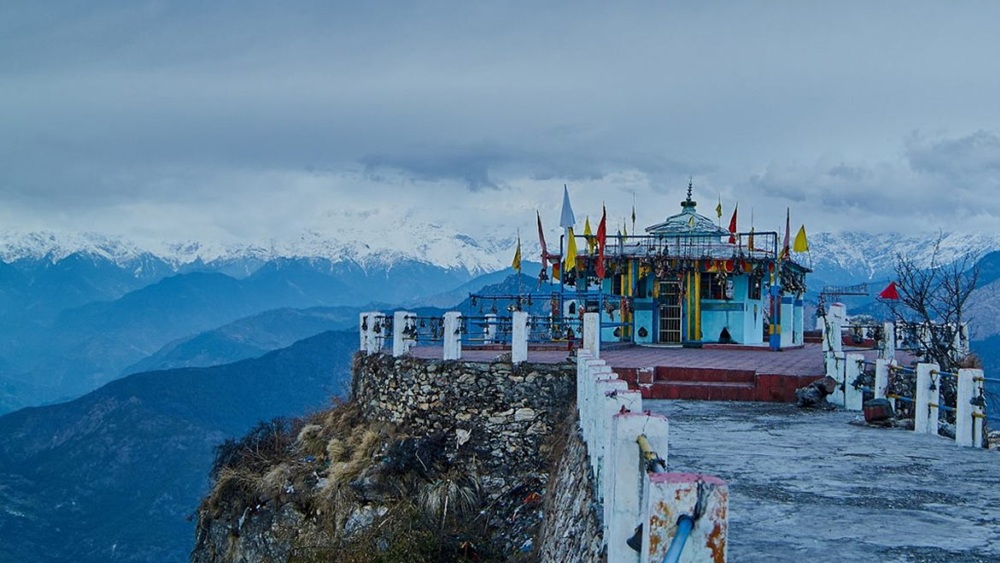
GEOGRAPHICAL SIGNIFICANCE AND LOCATION
Kartik Swami Temple is located near Kund village in Rudraprayag district, Uttarakhand, about 38 km from Rudraprayag town. The temple sits on a narrow ridge, surrounded by deep valleys and snow-clad Himalayan ranges including Nanda Devi, Chaukhamba, Trishul, and Bandarpunch.
The trek begins from Kanakchauri village, which is accessible by road from Rudraprayag. From there, it’s a 3 km uphill trek through dense oak and rhododendron forests. The location’s uniqueness lies in its combination of spirituality and adventure—offering both sacred worship and breathtaking Himalayan panoramas.
5. MAIN HIGHLIGHTS AND ATTRACTIONS
- The Temple and Idol – The temple is small yet powerful, housing an idol of Kartikeya’s skeletal remains, which symbolize sacrifice and devotion. Bells tied by devotees surround the shrine, creating a divine atmosphere.
- Panoramic Himalayan Views – The ridge offers a 360-degree view of the Himalayas, including Chaukhamba, Nanda Ghunti, Dronagiri, Neelkanth, and Trishul. Sunrises and sunsets here are truly mesmerizing.
- The Trek – The 3 km trek from Kanakchauri is moderately easy, making it suitable even for beginners. The trail passes through dense oak, pine, and rhododendron forests, with occasional glimpses of valleys below.
- Kartik Purnima Festival – Celebrated in November, this festival attracts locals and pilgrims who light lamps, sing bhajans, and offer prayers. It’s the most vibrant time to visit for a cultural experience.
- Peaceful Atmosphere – Unlike crowded temples, Kartik Swami retains a sense of solitude. It’s ideal for meditation, photography, and nature walks, making it a balanced destination for both spiritual and adventure tourism.
Insider Tip: Carry light snacks and water, as there are limited facilities near the temple. Sunrise is the best time to experience the grandeur of the mountains.
MIND-BLOWING FACTS AND TRIVIA
- The temple sits at 3,050 meters, offering one of the best sunrise points in Uttarakhand.
- It is one of the few temples dedicated solely to Lord Kartikeya in North India.
- Locals believe wishes made here with pure devotion come true.
- The surrounding forests are home to rare Himalayan birds, making it a hidden spot for birdwatchers.
- During winters, the entire trail gets covered in snow, making it a mini Himalayan snow trek.
🏞 Nearby Attractions Around Kartik Swami Temple
Ukhimath – Known as the winter seat of Kedarnath and Madhyamaheshwar deities, Ukhimath is a spiritual hub just 12 km from the temple base.
Chopta (Mini Switzerland of India) – Just 30 km away, Chopta is famous for its lush meadows, trekking trails, and as the base point for Tungnath and Chandrashila treks.
Tungnath Temple – The highest Shiva temple in the world, located at 3,680 meters. It’s a moderate trek from Chopta and offers stunning Himalayan views.
Chandrashila Peak – A short but steep trek from Tungnath, Chandrashila provides a panoramic view of Nanda Devi, Trishul, Kedarnath, and Chaukhamba peaks.
Rudraprayag – The sacred confluence of the Alaknanda and Mandakini rivers, about 40 km from Kartik Swami Temple.
Deoria Tal – A beautiful lake surrounded by forests and snow-capped peaks, around 55 km away from the temple. Perfect for camping and photography.
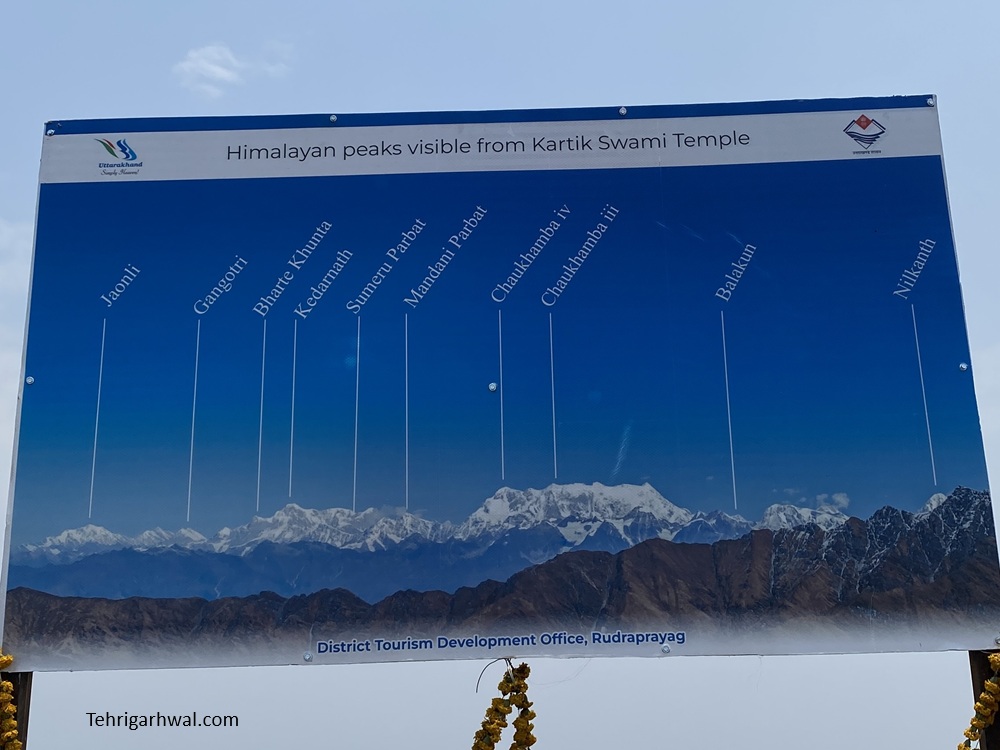
LATEST NEWS AND RECENT DEVELOPMENTS
As of 2025, Kartik Swami Temple has gained popularity among offbeat trekkers and spiritual travelers. The Uttarakhand Tourism Department has improved road connectivity between Rudraprayag and Kanakchauri, making the trek more accessible. In November 2024, during Kartik Purnima, over 5,000 pilgrims visited the temple—almost double compared to previous years, showcasing its rising recognition.
Efforts are also being made to promote eco-tourism in the region. Local homestays and guides are being trained under sustainable travel programs, ensuring visitors get an authentic cultural experience while preserving the natural environment. Additionally, new signboards and safety railings have been installed along the trek route to assist first-time visitors.
PRACTICAL TRAVEL TIPS AND RECOMMENDATIONS
- Best Time to Visit: March–June and October–November (clear skies, festive season). Winter treks (Dec–Feb) are possible but snow gear is essential.
- How to Reach: Nearest railway station – Rishikesh (approx. 190 km); nearest airport – Jolly Grant, Dehradun (approx. 200 km). Taxis and buses connect Rudraprayag to Kanakchauri.
- Trek Distance: 3 km from Kanakchauri, moderate difficulty.
- Accommodation: Homestays in Kanakchauri and Rudraprayag. Camping is possible near the temple with permission.
- What to Carry: Trekking shoes, warm clothes, flashlight, water, and snacks.
- Local Customs: Remove shoes before entering the shrine; respect the silence and devotion of pilgrims.
- Safety Tip: Avoid trekking during late evening or heavy rain.
PERSONAL EXPERIENCE OR STORY
Standing at Kartik Swami Temple during sunrise is an experience etched in memory. I remember reaching just before dawn, my breath visible in the cold air. As the first rays of sunlight touched Chaukhamba, the mountains glowed golden. The ringing of bells and chanting of prayers created an atmosphere that felt both otherworldly and grounding. It wasn’t just a trek or a visit—it was a reminder of how small yet connected we are to the vastness of the Himalayas.
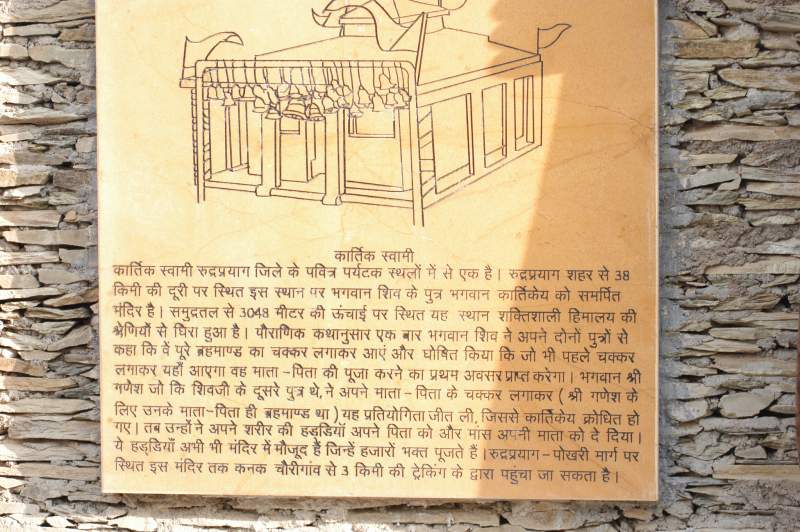
Frequently Asked Questions
Q1. How difficult is the trek to Kartik Swami Temple?
The trek is around 3 km from Kanak Chauri village. It’s a moderate trek suitable for beginners with a basic fitness level.
Q2. What is the best time to visit Kartik Swami Temple?
The temple is accessible throughout the year. Summer (April–June) offers clear skies, monsoon (July–September) brings lush greenery, and winter (November–February) gives snowy landscapes.
Q3. Is accommodation available near Kartik Swami Temple?
Yes, basic guesthouses and homestays are available at Kanak Chauri and Ukhimath. Chopta also offers campsites and eco-lodges for trekkers.
Q4. How can I reach Kartik Swami Temple?
From Rishikesh or Haridwar, take a bus/taxi to Rudraprayag → Ukhimath → Kanak Chauri (base village). From here, a 3 km trek leads to the temple.
Q5. Are there any facilities at the temple?
There are no restaurants or hotels at the temple. It’s advisable to carry your own water and snacks.
Q6. Can beginners or kids do the trek?
Yes, the trek is relatively easy and safe for families. However, in winters, snow may make the trail slippery, so proper footwear is essential.
Q7. Is photography allowed at Kartik Swami Temple?
Yes, photography of the scenic views is allowed, but inside the sanctum, it’s advised to follow temple rules.
CONCLUSION
The Kartik Swami Temple in Uttarakhand is more than a spiritual site—it’s a blend of mythology, adventure, and Himalayan beauty. From its fascinating legends to its stunning panoramas, the temple offers something truly unforgettable. Whether you seek blessings, a peaceful retreat, or a rewarding trek, Kartik Swami will not disappoint.
🌄 Ready to plan your visit? Share your experiences in the comments below and explore more Uttarakhand travel guides at tehrigarhwal.com. Don’t forget to follow us on social media for the latest Himalayan travel insights.

